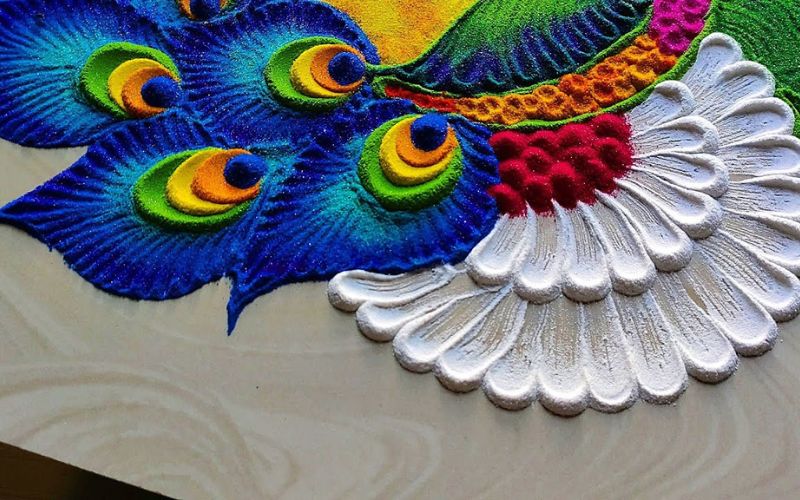Rangoli, an ancient Indian art form, has been a significant part of Indian culture for centuries. It is a creative expression that combines vibrant colors, intricate designs, and cultural symbolism. Among the myriad of rangoli designs, the Peacock Rangoli stands out as one of the most popular and admired. The peacock, with its stunning plumage and graceful demeanor, is not only India’s national bird but also a symbol of beauty, grace, and prosperity. This article delves into the intricate world of Peacock Rangoli designs, exploring its history, significance, techniques, and the steps involved in creating a mesmerizing Peacock Rangoli.
Historical Significance of Rangoli in Indian Culture
Rangoli, also known as Kolam in Tamil Nadu, Muggulu in Andhra Pradesh, and Alpana in Bengal, has been a part of Indian culture for thousands of years. Traditionally, women in India would create rangoli designs at the entrance of their homes as a welcoming gesture to guests and deities. The designs, made with natural powders like rice flour, turmeric, and vermilion, were believed to bring good luck and ward off evil spirits.
The peacock, a recurring motif in Indian art, has deep-rooted significance in Indian mythology and culture. It is associated with various deities, most notably Lord Krishna and Saraswati. The peacock’s vibrant colors and majestic form make it an ideal subject for rangoli designs, symbolizing beauty, love, and the divine.
The Art of Peacock Rangoli Design
Creating a Peacock Rangoli is an intricate process that requires skill, patience, and creativity. The design typically features a central peacock motif, surrounded by elaborate patterns and borders. The peacock’s feathers, with their iridescent hues and eye-catching patterns, are the focal point of the design. The challenge lies in capturing the peacock’s elegance and grace while maintaining the symmetry and flow of the rangoli.
Materials Required
Before diving into the creation process, it is essential to gather the necessary materials. For a Peacock Rangoli, you will need:
- Rangoli powders: These are available in a wide range of colors, including blues, greens, yellows, pinks, and purples. For a more traditional look, natural powders like turmeric, rice flour, and kumkum can be used.
- Stencils: For those new to rangoli, stencils can be helpful in creating the peacock’s outline and intricate patterns.
- Chalk or white pencil: Used to sketch the initial design on the floor.
- Dots or grid: Some artists prefer using a grid or dots to maintain symmetry in their designs.
- Cotton balls or swabs: Useful for blending colors and creating softer edges.
- Glitter or sequins: To add a touch of sparkle to the design.
Steps to Create a Peacock Rangoli
- Planning the Design: Start by planning your design on paper. Sketch out the peacock’s body, feathers, and surrounding patterns. This step is crucial as it helps visualize the final rangoli and ensures all elements are proportionate.
- Preparing the Surface: Clean the area where the rangoli will be created. A smooth, flat surface is ideal. Once the area is clean, use chalk or a white pencil to outline the peacock and any additional patterns. This outline will serve as a guide during the filling process.
- Creating the Outline: Begin by outlining the peacock’s body, head, and feathers. If you’re using a stencil, place it on the surface and gently fill in the outline with white rangoli powder. For freehand designs, carefully follow the sketched lines.
- Filling in the Colors: Once the outline is complete, start filling in the colors. Begin with the peacock’s body, using shades of blue and green. The feathers can be filled with a mix of blues, greens, and yellows. For the eyes and beak, use black and red. When filling in the colors, use a steady hand to avoid smudging the outline.
- Adding Details: After the primary colors are filled in, add details to the peacock’s feathers and body. Use darker shades for shading and lighter shades for highlights. You can also use cotton balls or swabs to blend the colors, creating a more realistic look.
- Enhancing the Design: Once the peacock is complete, move on to the surrounding patterns. These can include floral motifs, paisleys, or geometric designs. Use contrasting colors to make these patterns stand out. Finally, add glitter or sequins to enhance the design and give it a festive look.
- Final Touches: Step back and review your work. Make any necessary adjustments, such as smoothing out edges or adding more details. Once satisfied, your Peacock Rangoli is complete!
Significance of Peacock Rangoli Designs in Festivals and Celebrations
Peacock Rangoli designs are particularly popular during festivals like Diwali, Pongal, and Navratri. During these occasions, homes are decorated with vibrant rangolis to welcome guests and deities. The peacock, with its association with beauty and prosperity, is a favored motif during these celebrations.
- Diwali: During the Festival of Lights, Peacock Rangolis are created at the entrance of homes to welcome Goddess Lakshmi, the goddess of wealth and prosperity. The colorful peacock design, illuminated by oil lamps and diyas, creates a mesmerizing sight, symbolizing light overcoming darkness.
- Pongal: In South India, during the harvest festival of Pongal, Peacock Rangolis are created as a tribute to the sun god, Surya. The peacock, representing the harvest and fertility, is a fitting symbol for this festival.
- Navratri: During the nine-day festival of Navratri, Peacock Rangolis are often created to honor the goddess Durga. The vibrant design is a reflection of the festive spirit and the triumph of good over evil.
Peacock Rangoli: A Fusion of Tradition and Modernity
While Peacock Rangoli designs have their roots in traditional Indian art, they have evolved to incorporate modern elements. Today, artists experiment with different mediums, techniques, and colors to create unique and innovative designs. Some popular trends include:
- 3D Rangoli: Artists use shading and perspective to create a three-dimensional effect, making the peacock appear lifelike. This technique requires a high level of skill and precision.
- Rangoli with Flowers: Instead of traditional powders, fresh flowers like marigolds, roses, and chrysanthemums are used to create the design. This not only adds fragrance but also brings the design to life with natural textures and colors.
- LED Rangoli: In modern homes, LED lights are used to outline the Peacock Rangoli, creating a stunning visual effect, especially during nighttime. This fusion of traditional art with modern technology is a reflection of the changing times.
- Digital Rangoli: With the advent of technology, digital rangoli designs have gained popularity. Artists use software to create intricate Peacock Rangoli designs, which can then be projected onto the floor or printed on large canvases.
Cultural Impact and Symbolism of the Peacock in Rangoli
The peacock holds a special place in Indian culture, not only as a national bird but also as a symbol of various virtues. In the context of rangoli, the peacock represents:
- Beauty and Grace: The peacock’s elegant form and vibrant colors symbolize beauty and grace. In rangoli, the peacock is often depicted in its full splendor, with its feathers spread out, showcasing the artist’s skill and creativity.
- Prosperity and Good Fortune: The peacock is believed to bring good luck and prosperity. Its inclusion in rangoli designs, especially during festivals, is a way of invoking blessings for the household.
- Spirituality: In Indian mythology, the peacock is associated with various deities. For example, the peacock is the mount of Lord Kartikeya, the god of war, and is also associated with Saraswati, the goddess of wisdom and learning. In rangoli, the peacock is often used as a spiritual symbol, representing divinity and enlightenment.
Tips for Beginners
Creating a Peacock Rangoli can be intimidating for beginners, but with practice and patience, anyone can master this art form. Here are some tips to help you get started:
- Start Simple: Begin with a basic peacock design, focusing on the outline and primary colors. As you gain confidence, you can add more details and experiment with different patterns.
- Use Stencils: If freehand drawing is challenging, use stencils to create the peacock’s outline. This will help you maintain symmetry and proportion.
- Practice on Paper: Before creating the rangoli on the floor, practice your design on paper. This will give you a better understanding of the proportions and color combinations.
- Blend Colors: Use cotton balls or swabs to blend colors and create smooth transitions. This will add depth and dimension to your rangoli.
- Be Patient: Rangoli is a time-consuming art form that requires patience and precision. Take your time with each step, and don’t rush the process.
Conclusion
Peacock Rangoli is more than just a decorative art form; it is a celebration of Indian culture, tradition, and spirituality. The intricate designs, vibrant colors, and symbolic significance make it a cherished part of Indian festivals and celebrations. Whether you are a seasoned artist or a beginner, creating a Peacock Rangoli is a rewarding experience that allows you to express your creativity while connecting with a rich cultural heritage.
As you embark on your journey to create a Peacock Rangoli, remember that the true beauty of this art form lies in the joy



